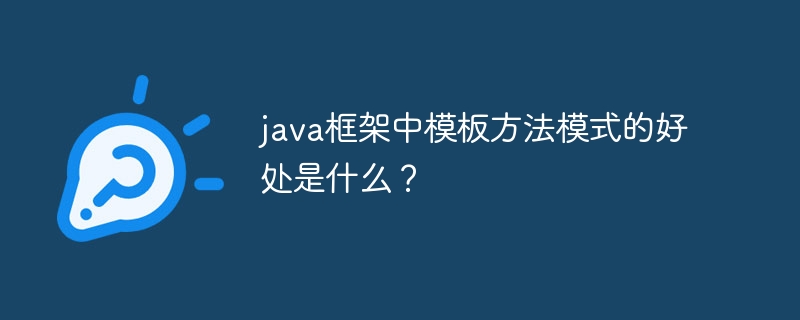 Java
Java javaTutorial
javaTutorial Applying template method pattern and proxy pattern in Java: improving code reusability
Applying template method pattern and proxy pattern in Java: improving code reusability
Improving code reusability: exploring the application of template method pattern and proxy pattern in Java
Introduction:
In software development, code reuse is a A very important technical means, it can greatly improve development efficiency, reduce code redundancy, and help maintain and manage code. In the Java language, the template method pattern and the proxy pattern are two commonly used design patterns, which can help us achieve code reuse. This article will introduce the concepts and application scenarios of these two design patterns in detail, and demonstrate their practical application in the Java language through specific code examples.
1. Template method pattern
- Concept:
The template method pattern refers to defining the skeleton of an algorithm and deferring the specific implementation of some steps to subclasses. It can provide a stable algorithm framework and allow subclasses to redefine certain steps in the algorithm without changing the algorithm structure. - Application scenarios:
The template method pattern is often used in the following situations: - There are some common steps in different instances of an algorithm, but the specific implementation is different.
- Some algorithm steps in subclasses can be reused, while subclasses are allowed to modify specific algorithm steps.
- Code example:
The following is a simple example to demonstrate the application of the template method pattern in the Java language. Assume that there is an abstract class Animal and two concrete subclasses Cat and Dog, both of which have the same lifestyle, but there are some differences in details. We will implement this example using the Template Method pattern.
abstract class Animal {
public void live() {
eat();
sleep();
play();
}
public abstract void eat();
public abstract void sleep();
public abstract void play();
}
class Cat extends Animal {
public void eat() {
System.out.println("猫吃鱼");
}
public void sleep() {
System.out.println("猫睡觉");
}
public void play() {
System.out.println("猫玩耍");
}
}
class Dog extends Animal {
public void eat() {
System.out.println("狗吃骨头");
}
public void sleep() {
System.out.println("狗睡觉");
}
public void play() {
System.out.println("狗玩球");
}
}
public class Main {
public static void main(String[] args) {
Animal cat = new Cat();
cat.live();
Animal dog = new Dog();
dog.live();
}
}In the above code, the Animal class is an abstract class, which defines a live() method, which is the skeleton of the entire algorithm, in which some common steps are defined and some The specific implementation of the steps is left to subclasses. The Cat class and the Dog class are subclasses of Animal respectively. They implement the eat(), sleep() and play() methods, and perform different implementations according to the specific subclasses, thereby achieving code reuse and expansion.
2. Proxy pattern
- Concept:
The proxy pattern is a structural design pattern that controls access to actual objects by introducing proxy objects. The proxy object acts as an interface to the actual object, and the client indirectly accesses the actual object through the proxy object. - Application scenarios:
The proxy mode is often used in the following situations: - It is necessary to add additional functionality without changing the actual object.
- Need to make some controls and restrictions on the actual objects.
- Need to provide some convenient access methods to the actual objects.
- Code example:
The following is a simple example to demonstrate the application of the proxy mode in the Java language. Assume that there is an interface Image and an implementation class RealImage. We hope to do some additional things before accessing the actual image. Operations, such as detecting whether pictures exist, recording logs, etc. We will implement this example using the proxy pattern.
interface Image {
void display();
}
class RealImage implements Image {
private String fileName;
public RealImage(String fileName) {
this.fileName = fileName;
loadFromDisk();
}
private void loadFromDisk() {
System.out.println("从磁盘加载图片:" + fileName);
}
public void display() {
System.out.println("显示图片:" + fileName);
}
}
class ProxyImage implements Image {
private String fileName;
private RealImage realImage;
public ProxyImage(String fileName) {
this.fileName = fileName;
}
public void display() {
if (realImage == null) {
realImage = new RealImage(fileName);
}
realImage.display();
}
}
public class Main {
public static void main(String[] args) {
Image image = new ProxyImage("test.jpg");
image.display();
}
}In the above code, Image is an interface, RealImage is the implementation class of Image, and ProxyImage is a proxy class. In ProxyImage, by introducing the RealImage object, the actual image display operation is delegated to RealImage. In the client code, we only need to use the ProxyImage object to access the image without directly operating the RealImage object. Through the proxy object, we can perform some additional operations before accessing the actual image, such as detecting whether the image exists, recording logs, etc.
Conclusion:
By using the template method pattern and proxy pattern, we can improve the reusability of the code and increase the flexibility and scalability of the code. The template method pattern provides a stable algorithm framework that allows subclasses to rewrite and modify it according to actual conditions. The proxy pattern allows us to add additional functionality and control without changing the actual object by introducing proxy objects.
When we are faced with the need to reuse existing code, or add new functions without changing the original code, we might as well consider using the template method pattern and proxy pattern, which can help us implement the code. Reuse and extend, improve development efficiency, reduce code redundancy, and help maintain and manage code. I hope that through the introduction and code examples of this article, readers can have a clearer understanding of the template method pattern and the proxy pattern, so that they can be better applied to actual software development.
The above is the detailed content of Applying template method pattern and proxy pattern in Java: improving code reusability. For more information, please follow other related articles on the PHP Chinese website!
 Java语言中的IoC和AOP的应用Jun 10, 2023 pm 12:10 PM
Java语言中的IoC和AOP的应用Jun 10, 2023 pm 12:10 PM在Java语言中,IoC(InversionofControl)和AOP(AspectOrientedProgramming)是两种非常重要的编程思想和技术。它们的应用可以大大提高代码的可维护性、可扩展性和可重用性,从而帮助开发人员更加高效地开发和维护软件系统。IoC是一种面向对象设计模式,也被称为“依赖注入(DependencyInjection
 java框架中模板方法模式的好处是什么?Jun 05, 2024 pm 08:45 PM
java框架中模板方法模式的好处是什么?Jun 05, 2024 pm 08:45 PM模板方法模式定义了算法框架,由子类实现特定步骤,优点包括可扩展性、代码重用和一致性。实战案例中,饮品制作框架使用该模式创建了可定制的饮品制作算法,包括coffee和tea类,它们可以在保持一致性的同时定制冲泡和调味步骤。
 如何解决在 Windows 11 上写入代理设置访问被拒绝的错误?May 06, 2023 pm 10:37 PM
如何解决在 Windows 11 上写入代理设置访问被拒绝的错误?May 06, 2023 pm 10:37 PM许多Windows11用户报告在系统启动时或尝试通过命令提示符执行命令时看到错误消息“写入代理设置时出错-访问被拒绝”。通常,当尝试运行任何命令或升级到Windows操作系统后,某些安装不正确的第3方应用程序可能会干扰命令提示符时,会出现此错误。您是否对Windows11计算机上的此错误写入代理设置消息感到困扰?然后,您已到达正确的位置。在本文中,我们策划了一些可能的解决方案,可帮助您解决计算机上的此问题。修复1–更改Windows的默认终端应用程序您是否从Windo
 优化Java应用性能的关键:JVM内存参数配置Feb 18, 2024 pm 02:18 PM
优化Java应用性能的关键:JVM内存参数配置Feb 18, 2024 pm 02:18 PMJVM内存参数设置:如何优化Java应用的性能?引言:在Java应用程序开发中,优化性能是一个非常重要的任务。而对Java虚拟机(JVM)的内存参数进行合理的设置,可以有效地提升应用程序的性能。本文将介绍一些常用的JVM内存参数,并给出具体的代码示例,帮助读者更好地理解如何优化Java应用的性能。一、JVM内存参数的重要性JVM是Java应用程序的运行环境,
 java框架中代理模式的优缺点有哪些?Jun 03, 2024 am 09:34 AM
java框架中代理模式的优缺点有哪些?Jun 03, 2024 am 09:34 AM代理模式是一种Java框架设计模式,通过创建代理对象在客户端和目标对象之间进行中介。它的优势包括:保护目标对象,提供数据完整性和安全性;控制对目标的访问,实现权限控制和安全措施;增强目标行为,添加额外功能如日志记录、缓存和事务管理;简化测试,便于mocking和stubbing目标。然而,代理模式也存在劣势:开销:创建和维护代理对象可能降低性能;复杂性:需要深入理解设计模式;限制对目标的访问,可能在某些情况下不合适。
 PHP 设计模式:通往代码卓越的道路Feb 21, 2024 pm 05:30 PM
PHP 设计模式:通往代码卓越的道路Feb 21, 2024 pm 05:30 PM导言PHP设计模式是一组经过验证的解决方案,用于解决软件开发中常见的挑战。通过遵循这些模式,开发者可以创建优雅、健壮和可维护的代码。它们帮助开发者遵循SOLID原则(单一职责、开放-封闭、Liskov替换、接口隔离和依赖反转),从而提高代码的可读性、可维护性和可扩展性。设计模式的类型有许多不同的设计模式,每种模式都有其独特的目的和优点。以下是一些最常用的php设计模式:单例模式:确保一个类只有一个实例,并提供一种全局访问此实例的方法。工厂模式:创建一个对象,而不指定其确切类。它允许开发者根据条件
 利用Java技能寻找符合自己需求的就业机会的方法Jan 30, 2024 am 09:53 AM
利用Java技能寻找符合自己需求的就业机会的方法Jan 30, 2024 am 09:53 AM如何利用Java知识找到适合自己的工作?近年来,Java程序员的需求量一直稳定增长,因此学习Java语言成为很多人提升就业竞争力的首选。然而,仅仅掌握Java语言并不足以保证找到适合自己的工作。在找工作的过程中,应当综合考虑自身的技能水平、兴趣爱好、职业规划等因素,并将Java知识灵活运用。本文将从准备阶段、求职途径、技能提升和职业发展等方面,探讨如何利用J
 Java 中的代理模式Jun 07, 2023 pm 11:22 PM
Java 中的代理模式Jun 07, 2023 pm 11:22 PMJava中的代理模式代理是设计模式中的一种,它允许对象以另一个对象的形式出现,通过代理对象来访问原始对象。代理在许多应用程序中都得到广泛使用,其中最常见的应用是在网络中实现远程对象调用和日志记录。Java中也有许多使用代理模式的例子。Java中的代理模式主要是通过以下三种方式实现的:静态代理静态代理是通过在编译阶段创建代理类来实现的。代理类和原始类实现


Hot AI Tools

Undresser.AI Undress
AI-powered app for creating realistic nude photos

AI Clothes Remover
Online AI tool for removing clothes from photos.

Undress AI Tool
Undress images for free

Clothoff.io
AI clothes remover

AI Hentai Generator
Generate AI Hentai for free.

Hot Article

Hot Tools

PhpStorm Mac version
The latest (2018.2.1) professional PHP integrated development tool

Atom editor mac version download
The most popular open source editor

ZendStudio 13.5.1 Mac
Powerful PHP integrated development environment

SAP NetWeaver Server Adapter for Eclipse
Integrate Eclipse with SAP NetWeaver application server.

EditPlus Chinese cracked version
Small size, syntax highlighting, does not support code prompt function





